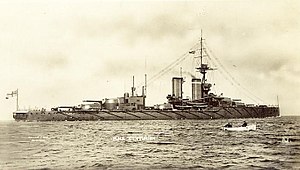 A postcard of Centurion under way, about 1913
| |
| History | |
|---|---|
| Name | Centurion |
| Namesake | Roman centurion |
| Builder | HM Dockyard, Devonport |
| Laid down | 16 January 1911 |
| Launched | 18 November 1911 |
| Commissioned | 22 May 1913 |
| Decommissioned | 1924 |
| Reclassified | As a target ship, 1927 |
| Fate | Sunk as a Mulberry harbour blockship off Normandy, 7 June 1944 |
| General characteristics (as built) | |
| Class and type | King George V-class dreadnought battleship |
| Displacement | 25,420 long tons (25,830 t) (normal) |
| Length | 597 ft 9 in (182.2 m) (o/a) |
| Beam | 89 ft 1 in (27.2 m) |
| Draught | 28 ft 8 in (8.7 m) |
| Installed power |
|
| Propulsion | 4 × shafts; 2 × steam turbine sets |
| Speed | 21 knots (39 km/h; 24 mph) |
| Range | 6,310 nmi (11,690 km; 7,260 mi) at 10 knots (19 km/h; 12 mph) |
| Complement | 862 (1913) |
| Armament |
|
| Armour | |
HMS Centurion was the second of four King George V-class dreadnought battleships built for the Royal Navy in the early 1910s. She spent the bulk of her career assigned to the Home and Grand Fleets. Aside from participating in the failed attempt to intercept the German ships that had bombarded Scarborough, Hartlepool and Whitby in late 1914, and the Battle of Jutland in May 1916, her service during the First World War generally consisted of routine patrols and training in the North Sea.
By the end of 1919, Centurion had been transferred to the Mediterranean Fleet. Although she spent much of her time in reserve, she had a peripheral role in the Allied intervention in the Russian Civil War. After her return home in 1924, the ship became the flagship of the Reserve Fleet. In 1926 Centurion was converted into a target ship and participated in trials evaluating the effectiveness of aerial bombing in addition to her normal duties. During the Second World War, the ship was rearmed with light weapons and was converted into a blockship in 1941. When that operation was cancelled, she was then modified into a decoy with dummy gun turrets in an attempt to fool the Axis powers. Centurion was sent to the Mediterranean in 1942 to escort a convoy to Malta, although the Italians quickly saw through the deception. The ship was deliberately sunk during the Invasion of Normandy in 1944 to form a breakwater.